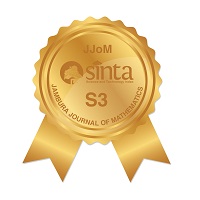Analisis Sentimen Pengguna Twitter Menggunakan Support Vector Machine Pada Kasus Kenaikan Harga BBM
Abstract
Keywords
Full Text:
PDFReferences
N. M. Ardani, "Studi komparatif reaksi pasar sebelum dan sesudah kenaikan harga bbm atas saham lq-45 di bei (even study pada peristiwa kenaikan bbm tanggal 5 januari 2017)" Jurnal Pendidikan Ekonomi Undiksha, vol. 10, no. 2, pp. 616-626, 2019, doi: 10.23887/jjpe.v10i2.20142.
J. C. Sihombing, "Kenaikan harga bbm : Jahat atau sepakat..???" 2022, [Online] Available: https://www.djkn.kemenkeu.go.id/kpknl-sidempuan/baca-artikel/15373/Kenaikan-Harga-BBM-Jahat-atau-Sepakat.htmlhttps://www.djkn.kemenkeu.go.id/kpknl-sidempuan/baca-artikel/15373/Kenaikan-Harga-BBM-Jahat-atau-Sepakat.html.
B. C. Sandy, D. Manongga, and A. Iriani, "Analisis sentimen terhadap kenaikan harga bahan bakar minyak (bbm) pada media online" in Seminar Nasional & Konferensi Ilmiah Sistem Informasi, Informatika & Komunikasi, 2015, pp. 24-30, [Online] Available: https://publikasi.uyelindo.ac.id/index.php/semmau/article/view/56/35.
C. M. Annur, "Pengguna twitter di indonesia capai 24 juta hingga
awal 2023, peringkat berapa di dunia?" Databoks, 2023, [Online] Available: https://databoks.katadata.co.id/datapublish/2023/02/27/pengguna-twitter-di-indonesia-capai-24-juta-hingga-awal-2023-peringkat-berapa-di-dunia.
R. Tineges, A. Triayudi, and I. D. Sholihati, "Analisis sentimen terhadap layanan indihome berdasarkan twitter dengan metode klasifikasi support vector machine (SVM)" Jurnal Media Informatika Budidarma, vol. 4, no. 3, p. 650, jul 2020, doi: 10.30865/mib.v4i3.2181.
D. D. A. Yani, H. S. Pratiwi, and H. Muhardi, "Implementasi web scraping untuk pengambilan data pada situs marketplace" Jurnal Sistem dan Teknologi Informasi (JUSTIN), vol. 7, no. 4, p. 257, oct 2019, doi: 10.26418/justin.v7i4.30930.
R. S. Karan, K. K. Shirsat, P. L. Kasar, and R. Chaudhary, "Sentiment analysis on twitter data: A new approach" in 2018 International Conference on Current Trends towards Converging Technologies (ICCTCT). IEEE, mar 2018, doi: 10.1109/icctct.2018.8551169.
Y. A. Amrani, M. Lazaar, and K. E. E. Kadiri, "Random forest and support vector machine based hybrid approach to sentiment analysis" Procedia Computer Science, vol. 127, pp. 511-520, 2018, doi: 10.1016/j.procs.2018.01.150.
A. M. Pravina, I. Cholisoddin, and P. P. Adikara, "Analisis sentimen tentang opini maskapai penerbangan pada dokumen twitter menggunakan algoritme support vector machine (svm)" Jurnal Pengembangan Teknologi Informasi dan Ilmu Komputer, vol. 3, no. 3, pp. 2789-2797, 2019, [Online] Available: https://j-ptiik.ub.ac.id/index.php/j-ptiik/article/view/4793/2232.
N. M. Ali, M. M. A. E. Hamid, and A. Youssif, "Sentiment analysis for movies reviews dataset using deep learning models" International Journal of Data Mining & Knowledge Management Process (IJDKP), vol. 09, no. 03, pp. 19-27, may 2019, doi: 10.5121/ijdkp.2019.9302.
S. Styawati, N. Hendrastuty, and A. R. Isnain, "Analisis sentimen masyarakat terhadap program kartu prakerja pada twitter dengan metode support vector machine" Jurnal Informatika: Jurnal Pengembangan IT, vol. 6, no. 3, pp. 150-155, 2021, [Online] Available: http://ejournal.poltektegal.ac.id/index.php/informatika/article/view/2870.
K. M. O. Nahar, M. Al-Shannaq, A. Manasrah, R. Alshorman, and I. Alazzam, "A holy quran reader/reciter identification system using support vector machine" International Journal of Machine Learning and Computing, vol. 9, no. 4, pp. 458-464, aug 2019, doi: 10.18178/ijmlc.2019.9.4.826.
J. Saranya and R. R. M.E, "Classification of benign and malignant tumour using svm" International Journal of Recent Trends in Engineering & Research (IJRTER), vol. 05, no. Special Issue 07, pp. 105-110, mar 2019, doi: 10.23883/ijrter.conf.20190304.017.hrer2.
A. Priyanto and M. R. Maarif, "Implementasi web scrapping dan text mining untuk akuisisi dan kategorisasi informasi dari internet (studi kasus: Tutorial hidroponik)" Indonesian Journal of Information Systems, vol. 1, no. 1, pp. 25-33, aug 2018, doi: 10.24002/ijis.v1i1.1664.
W. Bourequat and H. Mourad, "Sentiment analysis approach for analyzing iPhone release using support vector machine" International Journal of Advances in Data and Information Systems, vol. 2, no. 1, pp. 36-44, apr 2021, doi: 10.25008/ijadis.v2i1.1216.
S. Menaka and N. Radha, "Text classification using keyword extraction technique" International Journal of Advanced Research in Computer Science and Software Engineering, vol. 3, no. 12, pp. 734-740, 2013.
D. R. Manalu, M. C. L. Tobing, and M. Yohanna, "Analisis sentimen twitter terhadap wacana penundaan pemilu dengan metode support vector machine" METHOMIKA Jurnal Manajemen Informatika dan Komputerisasi Akuntansi, vol. 6, no. 6, pp. 149-156, oct 2022, doi: 10.46880/jmika.vol6no2.pp149-156.
O. Somantri, S. Wiyono, and D. Dairoh, "Metode k-means untuk optimasi klasifikasi tema tugas akhir mahasiswa menggunakan support vector machine (SVM)" Scientific Journal of Informatics, vol. 3, no. 1, pp. 34-45, jun 2016, doi: 10.15294/sji.v3i1.5845.
M. Belouch, S. E. Hadaj, and M. Idhammad, "Performance evaluation of intrusion detection based on machine learning using apache spark" Procedia Computer Science, vol. 127, pp. 1-6, 2018, doi: 10.1016/j.procs.2018.01.091.
D. T. Wisudawati, T. W. Utami, and P. R. Arum, "Analisis sentimen terhadap dampak covid-19 pada performa tokopedia menggunakan support vector machine" in Seminar Nasional Variansi, 2020.
A. P. Putra, N. N. Debataraja, and D. Kusnandar, "Tingkat akurasi klasifikasi jarak kelahiran di kampung keluarga berencana (kb) dengan metode support vector machine (svm)" Bimaster: Buletin Ilmiah Matematika, Statistika dan Terapannya, vol. 9, no. 3, 2020, [Online] Available: https://jurnal.untan.ac.id/index.php/jbmstr/article/view/40891.
H. Yun, "Prediction model of algal blooms using logistic regression and confusion matrix" International Journal of Electrical and Computer Engineering (IJECE), vol. 11, no. 3, p. 2407, jun 2021, doi: 10.11591/ijece.v11i3.pp2407-2413.
DOI: https://doi.org/10.34312/jjom.v5i2.20860
Copyright (c) 2023 Rahadi Ramlan, Neva Satyahadewi, Wirda Andani

This work is licensed under a Creative Commons Attribution-NonCommercial 4.0 International License.
Jambura Journal of Mathematics has been indexed by
Jambura Journal of Mathematics (e-ISSN: 2656-1344) by Department of Mathematics Universitas Negeri Gorontalo is licensed under a Creative Commons Attribution-NonCommercial 4.0 International License. Powered by Public Knowledge Project OJS.
Editorial Office
Department of Mathematics, Faculty of Mathematics and Natural Science, Universitas Negeri Gorontalo
Jl. Prof. Dr. Ing. B. J. Habibie, Moutong, Tilongkabila, Kabupaten Bone Bolango, Gorontalo, Indonesia
Email: [email protected].



















